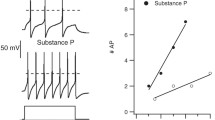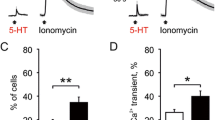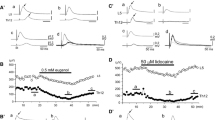Abstract
The aim of the present study was to investigate how prostaglandin E2 (PGE2) affects the excitability of trigeminal root ganglion (TRG) neurons, projecting onto the superficial layer of the cervical dorsal horn, using fluorescence retrograde tracing and perforated patch-clamp techniques. TRG neurons were retrogradely labeled with fluorogold (FG). The cell diameter of FG-labeled neurons was small (< 30 μm). Under the voltage-clamp mode, application of PGE2 (0.01–10 μM) concentration-dependently increased the magnitude of the peak tetrodotoxin-resistant sodium current (TTX-R I Na) and this current was maximal at a concentration of 1 μM. One micromolar PGE2 application caused a hyperpolarizing shift of 8.3 mV in the activation curve for TTX-R I Na. In the current-clamp mode, the PGE2 (1 μM) application significantly increased the number of action potentials during the depolarizing step pulses as well as the level of overshoot but had no significant effect on the resting membrane potential. These results suggest that the excitability of small diameter TRG neurons seen after 1 μM PGE2 application is involved in an increase in the TTX-R I Na.




Similar content being viewed by others
References
Akopian AN, Sivilotti L, Wood JN (1996) A tetrodotoxin-resistant voltage-gated sodium channel expressed by sensory neurons. Nature 379:257–262
Arbuckle JB, Docherty RD (1995) Expression of tetrodotoxin-resistant sodium channels in capsaicin-sensitive dorsal root ganglion neurons of adult rats. Neurosci Lett 185:70–73
Arvidsson J, Raappana P (1989) An HRP study central projections from primary sensory neurons innervating the rat masetter muscle. Brain Res 480:111–118
Bar KJ, Natura G, Telleria-Diaz A, Teschner P, Vogel R, Vasquez E, Schaible HG, Ebersberger A (2004) Changes in the effect of spinal prostaglandin E2 during inflammation:prostaglandin E (EP1-EP4) receptors in spinal nociceptive processing of input from the normal or inflamed knee joint. J Neurosci 24:642–651
Bereiter DA, Hirata H, Hu JW (2000) Trigeminal subnucleus caudalis: beyond homologies with the spinal dorsal horn. Pain 88:221–224
Bevan S, Szolcssanyi J (1990) Sensory neuron-specific actions of capsaicin: mechanisms and applications. Trends Pharmacol Sci 11:330–333
Borgland SL, Connor M, Ryan RM, Ball HJ, Christie MJ (2002) Prostaglandin E2 inhibits calcium current in two sub-populations of acutely isolated mouse trigeminal sensory neurons. J Physiol (Lond) 539:433–444
Coimbra F, Coimbra A (1994) Dental noxious input reaches the subnucleus caudalis of the trigeminal complex in the rat, as shown by c-fos expression upon thermal or mechanical stimulation. Neurosci Lett 173:201–204
Cummins TR, Dib-Haji SD, Black JA, Akopian AN, Wood JN, Waxman SG (1999) A novel persistent tetrodotoxin resistant current in SNS-null wild type small primary sensory neurons. J Neruosci 19(RC439):1–6
Dallel R, Raboisson P, Auroy P, Woda A (1988) The rostral part of the trigeminal sensory complex is involved in orofacial nociception. Brain Res 448:1–19
Dib-Hajj SD, Black JA, Cummins TR, Kenney AM, Kocsis JD, Waxman SG (1998) Rescue of alpha-SNS sodium channel expression in small dorsal root ganglion neurons after axotomy by nerve growth factor in vivo. J Neurophysiol 79:2668–2676
Dray A (1995) Inflammatory mediators of pain. Br J Anaesth 75:125–131
England S, Bevan S, Docherty RJ (1996) PGE2 modulates the tetrodotoxin-resistant sodium current in neonatal rat dorsal root ganglion neurones via the cyclic AMP-protein kinase A cascade. J Physiol (Lond) 495:429–440
Fagan KA, Schaack J, Zweifach A, Cooper DM (2001) Adenovirus encoded cyclic nucleotide-gated channels: a new methodology for monitoring cAMP in living cells. FEBS Lett 500:85–90
Gold MS (1999) Tetrodotoxin-resistant Na+ currents and inflammatory hyperalgesia. Proc Natl Acad Sci USA 96:7645–7649
Gold MS, Levine JD, Correa AM (1998) Modulation of TTX-R INa by PKC and PKA and theier role in PGE2-induced sensitization of rat sensory neurons in vitro. J Neurosci 18:10345–10355
Hu HZ, Li ZW (1996) Substance P potentiates ATP-activated currents in rat primary sensory neurons. Brain Res 739:163–168
Kwong K, Lee L-Y (2005) Prostaglandin E2 potentiates a TTX-resistant sodium current in rat capsaicin-sensitive vagal pulmonary sensory neurons. J.Physiol 564:437–450
Kyrozis A, Reichling DB (1995) Perforated-patch recording with gramicidin avoids artifactual changes in intracellular chloride concentration. J Neurosci Methods 57:27–35
Light AR, Perl ER (1979) Reexanimation of dorsal root projection to the spinal dorsal horn including observations on the differential terminataion of course and fine fibers. J Com Neuol 186:117–131
Marfurt CF, Turner DF U (1984) The central projections of tooth pulp afferent neurons in the rat as determined by the transganglionic transport of horseradish peroxidase. J Comp Neurol 223:535–547
Matsumoto S, Takeda M, Tanimoto T (1999) Effects of electrical stimulation of the tooth pulp and phrenic nerve fibers on C1 spinal neurons in the rat. Exp Brain Res 126:351–358
Matsumoto S, Ikeda M, Yoshida S, Tanimoto T, Takeda M, Nasu M (2005) Prostaglandin E2-induced modification of tetrodotoxin-resistant Na+ currents involves activation of both EP2 and EP4 receptor in neonatal rat nodose ganglion neurones. Br J Pharmacol 145:503–513
Narumiya S, Sugimoto Y, Ushikubi F (1999) Prostanoid receptors structures: properties, and functions. Physiol Rev 79:1193–1226
Nishikawa T, Takeda M, Tanimoto T, Matsumoto S (2004) Convergence of nociceptive information from temporomandibular joint and tooth pulp afferents on C1 spinal neurons in the rat. Life Sci 75:1465–1478
Pearce RJ, Duchen MR (1994) Differential expression of membrane currents in dissociated mouse primary sensory neurons. Neuroscience 63:1041–1056
Pfaller K, Arvidsson J (1988) Central distribution of trigeminal and upper cervical primary afferents in the rat studied by anterograde transport of horseradish peroxidase conjugated to wheat germ agglutinin. J Comp Neurol 268:91–108
Puil E, Miura RM, Spigelman I (1989) Consequences of 4-aminopyridine applications to trigeminal root ganglion neurons. J Neurophysiol 62:810–820
Rae J, Cooper K, Gates P, Watsky M (1991) Low access resistance perforated patch recordings using amphotericin B. J Neurosci Methods 37:15–26
Razook JC, Chandler MJ, Foreman RD (1995) Phrenic afferent input excites C1-C2 spinal neurons in rats. Pain 63:117–125
Renganathan M, Cummins TR, Waxman SG (2001) Contribution of Nav1.8 sodium channels to action potential electrogenesis in DRG neurons. J Neurophysiol 86:629–640
Sangameswaran L, Delgado SG, Fish LM, Koch BD, Jakeman LB, Stewart GR, Sze P, Hunter JC, Eglen RM, Herman RC (1996) Structure and function of a novel voltage-gated, tetrodotoxin-resistant sodium channel specific to sensory neurons. J Biol Chem 271:5953–5956
Sessle BJ (1987) The neurobiology of facial and dental pain: present knowledge, future directions. J Dent Res 66:962–981
Strassman AM, Vos BP (1993) Somatotopic and laminar organization of fos-like immunoreactivity in the medullary and upper cervical dorsal horn induced by noxious facial stimulation in the rat. J Comp Neurol 331:495–516
Sugiura Y, Lee CL, Perl ER (1986) Central projections of identified unmyelinated (C) affrent fubers innervating mammalian skin. Science 234:358–361
Takeda M, Tanimoto T, Ikeda M, Nishikawa T, Kawanishi N, Mohri M, Shimizu T, Matsumoto S (1999) Changes in c-Fos expression induced by noxious stimulation in the trigeminal spinal nucleus caudalis and C1 spinal neurons of rats after hyperbaric exposure. Arch Histol Cytol 62:165–170
Takeda M, Tanimoto T, Ikeda M, Kadoi J, Nasu M, Matsumoto S (2004) Opioidergic modulation of excitability of rat trigeminal root ganglion neuron projections to the superficial layer of cervical dorsal horn. Neuroscience 125:995–1008
Takeda M, Tanimoto T, Ito M, Nasu M, Matsumoto S (2005) Role of capsaicin-sensitive primary afferent inputs from the masseter muscle in the C1 spinal neurons responding to tooth-pulp stimulation in rats. Exp Brain Res 160:107–117
Takeda M, Tanimoto T, Ikeda M, Nasu M, Kadoi J, Matsumoto S (2006) Enhanced excitability of rat trigeminal root ganglion neurons via decrease in the A-type potassium currents following temporomandibular inflammation. Neruoscience 138:621–630
Tanimoto T, Takeda M, Matsumoto S (2002) Suppressive effect of vagal afferents on cervical dorsal horn neurons responding to tooth pulp electrical stimulation in the rat. Exp Brain Res 145:468–479
Tate S, Benn S, Hick C, Trezise D, John V, Mannion RJ, Costigan M, Plumpton C, Grose D, Gladwell Z, Kendall G, Dale K, Bountra C, Woolf CJ (1998) Two sodium channels contribute to the TTX-R sodium current in primary sensory neurons. Nat Neuroscience 1:653–655
Yoshida S, Matsumoto S (2005) Effects of alpha-dendrotoxin on K+ currents and action potentials in tetrodotoxin-resistant adult rat trigeminal ganglion neurons. J Pharmacol Exp Ther 314:437–445
Zimmermann M (1983) Ethical guidelines for investigations of experimental pain in conscious animals. Pain 16:109–110
Author information
Authors and Affiliations
Corresponding author
Rights and permissions
About this article
Cite this article
Kadoi, J., Takeda, M. & Matsumoto, S. Prostaglandin E2 potentiates the excitability of small diameter trigeminal root ganglion neurons projecting onto the superficial layer of the cervical dorsal horn in rats. Exp Brain Res 176, 227–236 (2007). https://doi.org/10.1007/s00221-006-0608-2
Received:
Accepted:
Published:
Issue Date:
DOI: https://doi.org/10.1007/s00221-006-0608-2




